Maritime Museums - International

Click for United States Maritime Museums
Smith's Master Index to Maritime Museum Web Sites is helpful for researchers seeking information from all ports. His extensive list includes Virtual Maritime Museums.
Australian National Maritime Museum
Australia 1800s
The Australian National Maritime Museum, on the western shore of Sydney's DarlingHarbour, is in a lively heritage area with many attractions. The distinctive main building, with a roofline evoking waves and sails, houses exhibitions that explore Australia's links with the sea and consider how maritime activities and issues have shaped the lives of people in Australia.This museum has one of the largest fleets of any museum in the world. The 14 vessels include a former navy destroyer HMAS Vampire, a former navy submarine HMAS Onslow, a full-scale replica of Captain Cook's ship Endeavour and a variety of smaller vessels scaling down to an 8.6-metre couta fishing boat.
Because of gold strikes down under, population in Australia had gone from 405,356 in 1850 to 1,647,756 in 1870, vastly increasing the import of ships that brought in goods and mail.
Officially opened in 1991, the museum is relatively new; however, its collection already comprises more than 40,000 objects including:
- Ken Warby's 511 km/h jet-powered hydroplane Spirit of Australia - the fastest boat in the world.
- A celestial globe produced by the great Flemish cartographer Willem Janszoon Blaeu in 1602 to train Dutch East India Company navigators for their voyages to the southern hemisphere.
- The Charlotte Medal engraved by convict Thomas Barrett on the transport ship Charlotte in January 1788 at the end of the First Fleet's voyage from Britain to New South Wales.
British Columbia Maritime Museum, Victoria, B.C.
British Columbia 1800s
The Maritime Museum acquires artifacts, archival records, art works, publications and other historical reference material relating to maritime history and the maritime culture of Canada s West Coast. Its archival holdings include extensive collections of corporate and private records, personal papers, nautical charts, ship plans, and photographs. The Museum s collection spans from 1775 to the present, predominantly from 1900 to 1985. It includes:
- 35,000 artifacts
- Close to 40,000 photographs, including 8,000 of vessels
- Over 1,000 art works
- More than 10,000 items in the form of steamship ephemera, logbooks, ship records, personal papers, letters and journals
- Ship plans, representing 900+ vessels, primarily from the 1920s to 1960s and over 5,000 nautical charts with Admiralty hydrographic charts from the mid-1800s to present day Canadian hydrographic charts
- 8,000 books in our library and special collection.
China Maritime Museum, Hong Kong
Maritime China 1800s
Located at Pier 8, in the heart of the Central Harbour Waterfront, the Hong Kong Maritime Museum is a vibrant cultural institution dedicated to preserving, collecting and displaying objects that tell the story of trade and maritime in Hong Kong and the Pearl River Delta.
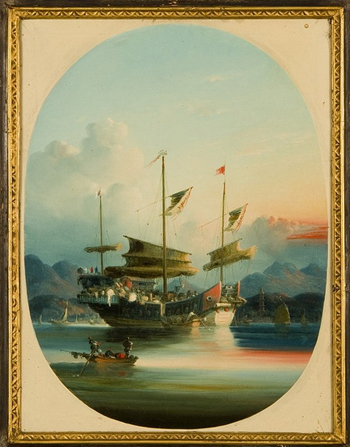 The Museum exhibits nearly 1,000 items across three levels and 15 galleries.
The Museum exhibits nearly 1,000 items across three levels and 15 galleries.
The China Trade: A rich collection of paintings and artefacts displayed gives testimony to the Canton Trade, an arrangement between China and foreign governments that limited trading to one port, Guangzhou, known to Europeans as Canton. This trade, which began in 1757, was plied by foreign merchants in a small group of thirteen ‘factories’ with Chinese `hong` or middlemen facilitating deals. The trade encompassed a range of Chinese produced goods, many of which are on display in the gallery and include tea, paintings, furniture, silks, hand-painted wallpapers, fans, lacquer ware, porcelain, ivories, pewter ware and silverware. A few western goods found a significant market for their own goods in return, making the trade one-sided. In the late 18th century, the British and Americans used the import of opium into China to redress the balance of trade, resulting ultimately in war and the end of the Canton Trade in 1839.
China Maritime Museum, Shanghai
Maritime China 1800s
China Maritime Museum is the only national maritime museum approved by the State Council of the People’s Republic of China and jointly built by the Ministry of Transport of China and Shanghai Municipal Peoples’ Government. Located by the Dishui Lake in Lingang New Town, Pudong New Area and occupying a land area of 24,830 square metres, it has a total floor space of 46,434 square meters, including an indoor display area of 21,000 square meters and an outdoor display area of 6,000 square meters.

China Maritime Museum functions for cultural relics collection, academic research, social education, exhibition and science popularization. With “navigation” as the theme and “historical items” as the basis, it is composed of six exhibition halls, two special exhibition zones, two science movie theatres and a children’s amusement centre.
By contrasting the past, present and future of China’s maritime industry, the Museum aims to foster the fine traditions of the Chinese nation and create a unique cultural atmosphere of Shanghai international shipping centre.
The main route through the museum features the major nautical developments in China throughout history, from models of early rafts up to examples of the clothing warn by modern day deep sea explorers. A significant portion of the museum is given over to Zheng He, the Muslim-Hui admiral who commanded voyages throughout southeast Asia and Africa and who was the subject of Gavin Menzies’ controversial 2002 book 1421: The Year China Discovered America, which posited that He visited the continent 70 years before Columbus.
Curacao (Kingdom of the Netherlands): Curacao Maritime Museum
Curacao 1800s
 The Curacao Maritime Museum takes visitors on a discovery tour through more than 500 years of the maritime history of Cura ao. The museum lays out the story-line through their permanent exhibition of displays with authentic nautical charts, ship models and navigation equipment combined with audiovisual techniques. A visit to this museum is an excellent way to spend a few hours: The museum is a short walk from ports of call for major shipping lines docking at the colorful town of Curacao; it features a fine restaurant with views of the town and harbor.
The Curacao Maritime Museum takes visitors on a discovery tour through more than 500 years of the maritime history of Cura ao. The museum lays out the story-line through their permanent exhibition of displays with authentic nautical charts, ship models and navigation equipment combined with audiovisual techniques. A visit to this museum is an excellent way to spend a few hours: The museum is a short walk from ports of call for major shipping lines docking at the colorful town of Curacao; it features a fine restaurant with views of the town and harbor.
Denmark: M/S Maritime Museum of Denmark, North Sealand
Danish Seaports 1800s
M/S Maritime Museum of Denmark is one of the main reasons why Helsing was on the New York Times list of 52 places to go in 2014! Numerous exhibitions telling the story of Denmark, as one of the leading maritime nations both past and present. The museum's rich collections are dramatically exhibited with larg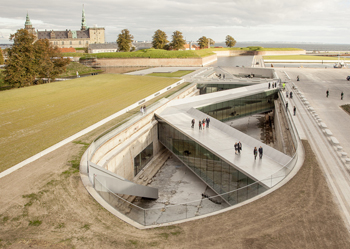 e video projections on the architecture. The Museum is subterranean, built around a dry dock adjacent to Kronborg Castle of Hamlet fame. For a century the site was a shipyard bustling with vessels and machinery, and the dry dock that now forms the centrepiece of the museum s underground building is a legacy of this yard. A series of three double-level bridges span the dry dock, serving both as an urban connection, as well as providing visitors with short-cuts to different sections of the museum.
e video projections on the architecture. The Museum is subterranean, built around a dry dock adjacent to Kronborg Castle of Hamlet fame. For a century the site was a shipyard bustling with vessels and machinery, and the dry dock that now forms the centrepiece of the museum s underground building is a legacy of this yard. A series of three double-level bridges span the dry dock, serving both as an urban connection, as well as providing visitors with short-cuts to different sections of the museum.
The long and noble history of the Danish Maritime unfolds in a continuous motion within and around the dock, 7 meters (23 ft.) below the ground. All floors - connecting exhibition spaces with the auditorium, classroom, offices, café and the dock floor within the museum - slope gently creating exciting and sculptural spaces.
Ny Kronborgvej 1, 3000 Helsing r.
England: Royal Museums, Greenwich
Maritime England 1800s
The Maritime Greenwich World Heritage Site is particularly noted for its magnificent architecture, beautiful parkland and a town centre. It is a pleasant and informative day tour for the family; boats leave from various points along the Thames.
 |
| England: Royal Greenwich Park, National Maritime Museum |
The site consists of the National Maritime Museum, the Royal Observatory Greenwich and the Queen's House in collaboration with The Cutty Sark Trust.
Greenwich began to develop as a cultural visitor destination with Sir James Thornhill's completion of the Painted Hall (1707 26) in what is now the Old Royal Naval College (founded in 1694 as the Royal Hospital for Seamen). From 1823 a "National Gallery of Naval Art," eventually including 300 portraits, paintings and artifacts, was created in the Hall, the first of its kind. A separate Naval Museum was also established in the Hospital buildings when it became the Royal Naval College the "Navy's university," 1873 1998.
The National Maritime Museum was formally established by Act of Parliament in 1934 and opened to the public by King George VI on 27 April 1937. The Museum has important holdings on the history of Britain at sea, including maritime art (both British and 17th-century Dutch), cartography, manuscripts including official public records, ship models and plans, scientific and navigational instruments, time-keeping and astronomy (based at the Observatory), and in many other categories. Its British portraits collection is only exceeded in size by the National Portrait Gallery and its holdings related to Nelson and Cook, among many other individuals, are unrivalled. It has the world's largest maritime historical reference library (100,000 volumes) including books dating back to the 15th century.
The Keeper: Lloyd’s Marine Collection
Collection of Corporation of Lloyd’s records containing: information on marine casualties and shipping movements worldwide back to c.1740 (sources include ‘Lloyd’s List’, ‘Lloyd’s Shipping Index’, war loss records, British Mercantile Navy Lists); Captains’ Registers (records of service of British foreign-going masters and mates) from 1868 to 1947.The Lloyd’s Marine Collection at Guildhall Library contains sources providing details of Merchant Navy vessels, shipping movements and casualties from the 18th century onwards. This publication is a comprehensive guide to the collection and related sources. It contains brief details of each source, including details of holdings, dates covered and a description of contents. It also provides advice on making searches on various subjects, noting the sources which may provide information. An invaluable guide for researchers using the Lloyd's Marine Collection.
London Metropolitan Archives, 40 Northampton Road, London, EC1R 0HB asklma@cityoflondon.gov.uk
England: Merseyside Maritime Museum, Albert Dock, Liverpool

Jesse Hartley (1780-1860) designed and built the Albert Dock and its warehouses. At the time he was surveyor to the Liverpool Dock Trustees and by far the highest-paid salaried engineer in the country. In the 36 years he spent working for the Liverpool Dock Trustees, Hartley either built or altered every dock in the city. The quality of his work and its longevity suggests that it was more than just a job to him - they are a testament to his dedication and attention to detail. His position gave Hartley the opportunity to deal with each dock as part of a whole system, rather than simply as a stand-alone basin. He was acutely aware of the importance of good communication between docks, through railways, canals and roads, as well as ease and safety of access for ships.
Estonia
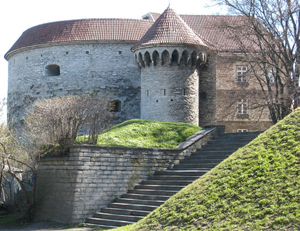 The Estonian Maritime Museum is located in Fat Margaret, an old cannon tower named for Margaret Sambiria, queen and consort of Christopher I of Denmark, who first ordered that defences be constructed around Tallinn in 1265. The tower was actually built from 1511 to 1530 as a defensive structure and was used as a prison between 1830 and 1917. Its exhibition provides an excellent overview of Estonia, surrounded by the Baltic Sea, the Gulf of Finland, Lake Peipus and Lake Pskov, as a maritime country.
The Estonian Maritime Museum is located in Fat Margaret, an old cannon tower named for Margaret Sambiria, queen and consort of Christopher I of Denmark, who first ordered that defences be constructed around Tallinn in 1265. The tower was actually built from 1511 to 1530 as a defensive structure and was used as a prison between 1830 and 1917. Its exhibition provides an excellent overview of Estonia, surrounded by the Baltic Sea, the Gulf of Finland, Lake Peipus and Lake Pskov, as a maritime country.
Four floors house a variety of items related to the sea – old-fashioned diving and fishing equipment, various items found on the sea bed, maritime charts and more. The museum also has a remarkable collection of model ships, from old sailing boats to modern submarines. Braver visitors climb onto the roof to enjoy the view of the Old Town and the sea.
Finland: Alands Sjofarts Museum
Finland 1800s
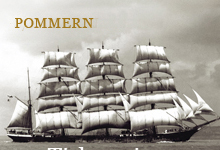 Åland Maritime Museum is a charitable trust dedicated to caring for Åland's maritime heritage, which includes administration of the Pommern, which is owned by Mariehamn town.
Our origins lie in the 1920s when Åland sea captain Carl Holmqvist started to collect nautical objects, realising the days of sailing ships were over. In 1935 he co-founded Åland Nautical Club with the aim of establishing a maritime museum for Åland. The museum, the older part of our building today, eventually opened in 1954.
Åland Maritime Museum is a charitable trust dedicated to caring for Åland's maritime heritage, which includes administration of the Pommern, which is owned by Mariehamn town.
Our origins lie in the 1920s when Åland sea captain Carl Holmqvist started to collect nautical objects, realising the days of sailing ships were over. In 1935 he co-founded Åland Nautical Club with the aim of establishing a maritime museum for Åland. The museum, the older part of our building today, eventually opened in 1954.
COLLECTIONS: Crankshafts and coffee pots, silk shawls and stoker's caps, figureheads and funnel symbols: our collections cover all aspects of Åland's maritime history from 18th century farmer-seafaring to modern global shipping. Our collections have been built up through the generous donations of individuals, shipping companies and other businesses and we gladly consider new donations.
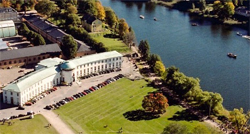 ARCHIVES:
Muster rolls, ships' logbooks, surveys and sea charts as well as personal letters and diaries. Some material is in English such as correspondence between shipping companies, brokers and chandlers. Also an excellent photographic archive with everything from commercial ship portraits to sailors' snapshots.
ARCHIVES:
Muster rolls, ships' logbooks, surveys and sea charts as well as personal letters and diaries. Some material is in English such as correspondence between shipping companies, brokers and chandlers. Also an excellent photographic archive with everything from commercial ship portraits to sailors' snapshots.
LIBRARY: Nautical literature relating to Åland and beyond, including Lloyd's shipping registers from 1764 onwards. You can check our catalogue via SÖK at Åland library's website.
France: Musee de la Marine Museum, Paris
French Seaports 1800s
 |
| Int rieur du port de Marseille |
| Claude-Joseph Vernet |
The Musee de la Marine is one of the largest maritime museums in the world and has a vast collection that relates to seafaring through the ages, but pays particular attention to the French Navy. The museum was founded in December 1827 through the initiative of King Charles X and since around 1940 has been located in the west wing of the Palais de Chaillot.
Prior to the late 1600's there were no plans drawn up for the construction of ships and it was around that same time that it became law that models were required to be produced, but like a blueprint with all the fine details and because these were just like a masterpiece in themselves, they became sought after as collectors pieces.

Through a collection of model ships owned by royalty, the idea of a museum was born, but never came about until many years later, but during the 1700's there were already avid collectors of these model ships. One such collector, Henri Louis Duhamel, who became the Inspector General of the Navy, created the Naval School of Engineering and Construction in 1741 and in 1748 offered King Louis XV his entire collection of model ships to be displayed in The Louvre. Then later on in 1801 the whole collection along with many other maritime objects was moved to a naval gallery at the Place de la Concorde.
The Muse de la Marine also has a model ship building studio, where you can watch the restorers at work, and the main purpose of this workshop is to restore models that are in the museum collection, by only using the original materials such as ebony and Oregon pine.
Musee de la Marine, Palais de Chaillot, 17 Place du Trocadero, 75116 Paris, France
Musee de marine Bora Bora, French Polynesia
French Polynesia 1800s
A most unusual day trip. A drive around the island of Bora Bora goes by the compact Marine Museum (below), which contains approximately 40 model ancient and modern canoes, fishing boats and ships reproduced by architect Bertrand Darasse. Each model relates directly or indirectly to Polynesian history.
The Bounty and the Kon Tiki are on display in 1/150 scale models, along with ships from early European explorers including Cook's Endeavour and Durmont d'Urville's L'Astrolabe of 1811, Bligh's Bounty and Alain Gerbault's Firecrest. Situated at the northern end of the island, it is open upon request only. PK11 north of Vaitape, near Faanui.Germany: Maritime Museums
Germany 1800s
- Stralsund-Dänholm
The Museum is located on Dänholm island as an outpost of the cultural-historic museum. Guided tours are recommended. Stralsund's naval history captured in a museum - the upper floor alone covers a vast topic: the Dänholm through the ages as the island of Dänholm has been strategically important for military actions since the Middle Ages, historical impressions, views and maps and the Stralsund fortress. Here information is available about the first Prussian marine depot and training facilities of the navy. A marine helicopter, a high-speed torpedo boat, various ship propellers and anchors range among the interesting exhibits.The island of Dänholm has been strategically important for military actions since the Middle Ages. ~ Sternschanze Dänholm Haus 10 - Internationales Maritimes Museum, Hamburg
Three thousand years worth of maritime history are displayed on nine ‘decks’ with precious exhibits, model ships and paintings. Medals and uniforms from navies around the world, displays of commercial and passenger shipping, as well as works by well-known maritime painters, are presented on other decks and the treasury holds ship models made of ivory, amber, silver and gold.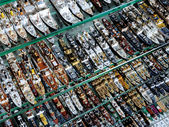 Historical documents and sea charts reveal how the modern world-view has developed. Particularly valuable: a copy of the „Atlantis Majoris“ from 1657, the first nautical atlas printed in the Netherlands.
Hand painted crown compasses and shining, golden sextants lead into an era in which a keen eye and steady hand were required to determine the course. A "signal station" with Teletype machinery and signal codes demonstrates how seafarers communicated up until the twentieth century.
An entire deck is reserved for marine research. The exhibit was developed in collaboration with leading scientific institutions and is constantly updated. Research instruments, samples from the sea bed, films that diving robots have taken of the deep sea, an actual wall of ice and fascinating underwater audio samples deliver a vivid impression of the seas.
Historical documents and sea charts reveal how the modern world-view has developed. Particularly valuable: a copy of the „Atlantis Majoris“ from 1657, the first nautical atlas printed in the Netherlands.
Hand painted crown compasses and shining, golden sextants lead into an era in which a keen eye and steady hand were required to determine the course. A "signal station" with Teletype machinery and signal codes demonstrates how seafarers communicated up until the twentieth century.
An entire deck is reserved for marine research. The exhibit was developed in collaboration with leading scientific institutions and is constantly updated. Research instruments, samples from the sea bed, films that diving robots have taken of the deep sea, an actual wall of ice and fascinating underwater audio samples deliver a vivid impression of the seas. - Deutsches Marinemuseum, Wilhelmhaven: Exhibitions in German and English, with a good overview of the Germany Navy from 1880 to 2010. Outside exhibits include a Type 205 submarine, a mine sweeper and the "Moelders," and a Charles F. Adams class destroyer.
- Deutsche Schiffahrtsmuseum Bremerhaven: The Deutsches Schiffahrtsmuseum (Maritime Museum of Germany) in Bremerhaven is located on the Weser river banks and includes a cog ship of 1380 that was found in Bremen in 1962. The museum building holds a fine and large collection of items focusing on naval technology development, naval history of Germany, models, flags, paintings and a mini U-boat built in 1944/45. In the museum harbour there are several vessels on display, of which the restaurant ship Seute Deern may be the best-known.
Ireland: National Maritime Museum of Ireland, Dublin
Ireland 1800s
Ireland’s National Maritime Museum is situated in the Old Mariners Church at D n Laoghaire a seaside town and port located circa 6 miles from Dublin city centre.

The museum’s greatest artefact is probably the building itself as it is one of a few custom built places of worship for sailors remaining intact in the world to-day. There are interesting mechanical exhibitions, including first class artefacts, on many aspects of the Irish maritime, wildlife around the Irish coastline including fish, birds and small animals, a maritime art gallery, a recreated ship’s radio room and a Titanic exhibition.
The National Maritime Museum houses an extensive collection on all aspects of maritime heritage, from the massive anchor in the museum courtyard to tiny models put together by the lighthouse keepers in the many lonely hours spent on duty off the coast of Ireland. Of the thousands of objects some hundreds are on display in the museum. Their web site alone is well-worth a visit. It is exceptionally well-designed: National Maritime Museum of Ireland
Italy: Galata Museu del Mare, the Darsena de Genova, Genoa
Italy 1800s
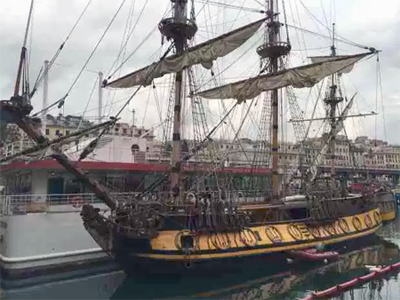 The Galata Museu del Mare, the largest maritime museum of the Mediterranean, is located in the ancient Darsena where, during the 1600s, the Republic of Genoa built and sailed its own fleet. An exhibition route which spreads over four floors entirely dedicated to the sea and to navigation, from the era of Christopher Columbus to the Ocean Liners, it is the ideal base for business dinners, conventions, meetings, conferences, receptions, private viewings, cocktail evenings, gala dinners and exclusive guided tours.The topic of voyaging is one of the recurring themes of the Galata Museo del Mare: voyages which, though able to rely upon technological developments in means of transport, have always involved man having to defy the unexpected that the seas and oceans have in store. The museum exhibition route, in chronological order, begins on the ground floor with the era of ships propelled by oars, and continues to the first and second floors with the story of sailing ships and the revolutionary geographical explorations, to the third floor which is entirely dedicated to the great transatlantic migrations.
The Galata Museu del Mare, the largest maritime museum of the Mediterranean, is located in the ancient Darsena where, during the 1600s, the Republic of Genoa built and sailed its own fleet. An exhibition route which spreads over four floors entirely dedicated to the sea and to navigation, from the era of Christopher Columbus to the Ocean Liners, it is the ideal base for business dinners, conventions, meetings, conferences, receptions, private viewings, cocktail evenings, gala dinners and exclusive guided tours.The topic of voyaging is one of the recurring themes of the Galata Museo del Mare: voyages which, though able to rely upon technological developments in means of transport, have always involved man having to defy the unexpected that the seas and oceans have in store. The museum exhibition route, in chronological order, begins on the ground floor with the era of ships propelled by oars, and continues to the first and second floors with the story of sailing ships and the revolutionary geographical explorations, to the third floor which is entirely dedicated to the great transatlantic migrations.
Japan: Yokohama Maritime Museum
Maritime Japan 1800s
Yokohama has a proud marine history as the site of one of the first seaports to be opened to the outside world. Yokohama Maritime Museum seeks to preserve the knowledge of the distant past and to tell the continuing story of Yokohama's development as a major world port.
The maritime museum is a combination of local Japanese maritime history and the science behind marine technologies. The museum also explains Yokohama's role as a major international port. The museum has numerous many hands-on and inventive displays. The set path through the museum starts with displays about the Nippon Maru and then continues to the lower floor. (The Nippon Maru is an active Japanese Navy training ship and can be seen in tall ships events around the world.) The outer side has displays about Yokohama port as it was after its forced opening by Perry's black ships and as it is today. The inner side of the lower floor is taken up by an extensive collection of models of historic and modern ships. There is also an extensive library on the west side. The final section on the 1st floor shows Yokohama Port's relationship to other world ports.

The Japanese sail training ship Nippon Maru was built in 1930 as a training ship for cadets. The ship brought up 11,500 cadets for 54 years until her retirement as a training ship in 1984. During her service, Nippon Maru logged 45.4 times around the earth (1,830,000 kilometers in total). The ship was placed under the authority of the City of Yokohama in 1984 and has been open to the public since 1985. Nippon Maru is also used for a full-sail exhibit in cooperation with volunteers and provides marine educational programs to students; she has sailed into San Francisco and other U.S. ports for various Tall Ships' events.
New Zealand Maritime Museum
New Zealand 1800s
After our first visit to the New Zealand in 2002, this Maritime Museum become a family favorite.
The museum is situated along Auckland's splendid waterfront, a ferry-boat ride away from lovely Devonport, and near historical buildings.

It houses stories of amazing journeys, courage, exploration and it houses records; this is where we first found records of Captain James H. Blethen's voyages to Australia and New Zealand during the 1800s when he opened the mail routes between the Sandwich Islands (Hawaii) and southern ports.
From their pages: A visit to Voyager begins by retracing the steps of the first human settlers to sail to New Zealand. Te Waka: Our great journey is a ten minute fully animated film which retells the mighty story of the arrival of the first migratory voyage to Aotearoa some 1,000 years ago. This epic adventure overcame monumental challenges to set the tone for New Zealand s pioneering future. Their acquisitions include:
- Polynesian and Maori vessels and navigation
- European voyages of discovery
- Settlement and immigration
- Early coastal trading
- Whaling and sealing
- Lifeboat services, piloting and coastguard activities
- Navigation and marine surveying
- Maritime art and crafts
- Maritime trades
- Harbour and port history
Norwegian Maritime Museum, Oslo, Norway
Norway 1800s
Museum for ship building, shipping, fishing and marine archaeology where you can see exhibitions, boat models and marine paintings. The Norwegian Maritime Museum is located on the waterfront at Bygd ynes on Bygd y peninsula. Norway's oldest boat, Stokkeb ten, is also exhibited at the museum. The museum's supervideograph, a panorama film about the Norwegian coast, is normally screened every half hour. Library, museum shop and caf . Norwegian name: Norsk Maritimt Museum.
Portugal: Museu de Marinha (Maritime Museum)
Maritime Portugal 1800s

The Navy Museum is administered by the Portuguese Navy and is located in the tourist district of Belem. The Maritime Museum of Lisbon is located in the celebrated Jeronimos Monastery (in fact, in the western wing of the edifice, sharing it with the National Museum of Archeology) and in an adjoining structure erected north of the monastery, representing one of the top tourist sights in Belem.
The museum dates back to 1863, when King Luis I began setting up a collection of sailing-related items.The mission of this museum is to keep alive the memory of the great naval achievements of Portugal starting from the age of the great geographical discoveries until now. The museum showcases an impressive 17,000-item collection comprising a miscellaneous range of exhibits: models of ships, old maps, boats, sailing instruments, charts, paintings and even archeological findings related to the field. Some of the highlights refer to Dutch Cartographer's Willem Jansz Blaeu’s terrestrial globe to a cabin from Queen Amelia’s yacht and to the Archangel Raphael’s wooden statue said to have been carried on Vasco da Gama’s ship on his way to India. Also worthy of interest are a collection of astrolabes (the largest in the world).
Praca do Imperio, 1400-206 Lisboa, Portugal.
Scottish Maritime Museum
The Scottish Maritime Museum is based in the west of Scotland, with sites in Irvine and Dumbarton. At these two sites, the Museum holds an important nationally recognized collection, embompassing a variety of historic ships, artifacts, shipbuilding machinery, machine tools, and personal items. Many of these exhibits are in the Linthouse Building in Irvine, a unique 19th century building known as the Linthouse Engine Shop Cathedral of Engineering and at the Denny Tank in Dumbarton, the world's first commercial ship model experiment tank.
National Archives of Scotland,
P.O.Box 36, General Register House, Princess Street, Edinburgh
Spain: Barcelona Maritime Museum
The Martime Museum itself is housed in the Drassanes Reals, the former royal shipyards, built between 1283 and 1328, and a superb example of Gothic architecture. Unfortunately, it is no longer on the seafront, but instead is engulfed by traffic. Among the museum's artefacts are ships of all shapes and sizes, dioramas and maps and things brought back to Europe from the Americas (tomatoes, potatoes, bananas, etc). Maritime Museum Barcelona Magellan's Santa Maria of a convoy of 5, is the only one to make it round the world. There's also a superb model of Magellan's Santa Mar a de la Victoria, which began Spain's first circumnavigation of the world (1519-1522). Magellan was beheaded enroute, so he didn't actually complete the voyage.
Spain: Galicia Museum of the Sea, Vigo
 The Galicia Museum of the Sea, in Vigo, is set in a stunning spot, washed by the waters of the Atlantic Ocean and the estuary. The museum features an aquarium, exhibition hall, exhibits on oceanography and aquaculture, and the Submarine of Sanjurjo Badia from the 19th century.
The Galicia Museum of the Sea, in Vigo, is set in a stunning spot, washed by the waters of the Atlantic Ocean and the estuary. The museum features an aquarium, exhibition hall, exhibits on oceanography and aquaculture, and the Submarine of Sanjurjo Badia from the 19th century.
The Cantabria Maritime Museum in Santander features marine species, historic photographs, engravings, boat building tools, fishing tackle and equipment, boats, and beautiful aquaria are some of the things you will find at the Cantabria Maritime Museum in Santander.
The Bilbao Estuary Maritime Museum, just 100 kilometres away, offers the chance to discover the close relationship that this city has maintained with its estuary, port and shipyards over the centuries.
Spain: Naval Museum, Madrid
The Naval Museum in Madrid is one of the most extensive of its type in Spain with Spain's seafaring history from the 15th century to the present day. Its exhibition also offers an overview of the navies of other countries with a major ethnographic collection, displayed in chronological order from the time of the Catholic Monarchs through to the present day, comprising stamps, medals, maps, paintings, nautical and scientific instruments, artillery, submarine weaponry, manuscripts...
Spain: Fundaction Nao Victoria
The foundation bears the name of the ship that sailed around the world in the 16th century. This non-profit entity is chaired by D. Juan Salas Tornero and promoted by Andalusian public and private institutions.
Projects include Sea Festivals and El Galeon, The Florida 500 Voyage. On April 2, 1513 Juan Ponce de Leon sailed to the land he called Florida. Their arrival began five centuries of Florida history in the large fleets of Spanish galleons that transported goods and people between Spain and Florida for their settlement in the new world. 500 years later, The replica of a sixteenth-century Spanish galleon sailed along the coast of Florida in 2014, calling at ports along the east and west coasts of Florida.
Sweden: The Maritime Museum, Stockholm
The Maritime Museum is the central institution within Swedish National Maritime Museums; it also oversees its two sister museums, the Naval Museum and the Vasa Museum. The Maritime Museum is charged with the collection, conservation and exhibition of material relating to merchant shipping, shipbuilding and naval defence. The activities of the Museum bring to life Sweden's maritime heritage through exhibitions and activities, and collecting maritime objects of historic value. Exhibits include ships interiors, navigational instruments, weapons, figureheads, marlinspike seamanship, and art. It preserves the original cabin and sun-crowned stern of the schooner Amphion; It was on board the Amphion that Gustav III planned his strikes against Russia during the 1788 1790 war.
The merchant shipping history and naval history collections compare with the finest in the world. They comprise some 100,000 objects, including over 1500 models of ships and boats. There are also boat and ship drawings, paintings, weapons, uniforms and much else. Unique inventories, records, and extensive photographic collections, both historical and contemporary in their focus, make the Museum s archives essential sources for those with an interest in maritime culture.
Sweden: The South Baltic Programme 2014-2020
The maritime heritage on the seafloor off Kalmar and Blekinge regions in SouthEastern Sweden is unequalled in the world. A unique combination of geography, climate and a long period of seafaring has left behind a multitude of shipwrecks, with a history spanning over at least a thousand years. Advances in technology have made this heritage more ”visible” in the last decades and there is now a proactive interest from the heritage protection side to make this treasure available also for the general public. Not only is it important that the public is aware of the existence of these spectacular ”frozen moments” from our history; they are also an interesting way of highlighting maritime history via schools and museums as well as a possible source of revenue for the tourism industry.
The overall target is to make illustrate how seamarks have evolved over time and the imortance of them. As an activity in the exhibition maybe you should be able to “navigate” in some way between several points using lighthouses in a dark room?
Contact: Henrik Linnarsson
Näringslivsutvecklare
Tel direkt: +46 70 606 11 16, servicecenter: +46 485 880 00
Postadress: Box 52, 387 21 Borgholm
Besöksadress: Östra Kyrkogatan 10, Borgholm
henrik.linnarsson@borgholm.se
Welsh Maritime History
Wales 1800s
The vast majority of enquiries they receive fall into two main categories:
Requests for information about ships and the companies that owned them.
Requests for information on seafaring ancestors.
The main source of information on merchant shipping is Lloyd’s Register of Shipping; the museum holds copies dating back to 1836, with some earlier editions available as well.
For vessels of the Royal Navy, they hold J.J. Colledge’s Ships of the Royal Navy and a few editions of Jane’s Fighting Ships, mostly dating from the first and second world wars. The museum's photographic archive comprises views of some 6000 (mostly merchant) vessels, whilst specialist information is also available on various Welsh and UK shipping companies. The library holds a good selection of books on nineteenth and twentieth century British maritime history, with particular emphasis on the maritime heritage of Wales.
The museum does not possess records such as crew or passenger lists – these are held in other repositories, listed below. Two important guides on the subject are available in the museum library: Records of Merchant Shipping and Seamen by Kelvin Smith, Christopher Watts and Michael Watts, (Public Record Office, National Archive, 1998). Tracing your Naval Ancestors by Bruno Pappalardo, (Public Record Office, now the National Archive, 2002).
Useful websites for Welsh seafarers:

- www.swanseamariners.org.uk
- www.welshmariners.org.uk:
Morwyr Cymru Mynegai ar-lein i 23,500 meistri, mêtiau a pheiriannwyr masnachnol o Gymry o 1800 tan 1945, casglwyd gan Dr. Reg Davies.The core of the site is a database of (currently) over 23,500 Welsh Merchant Mariners active from 1800 to 1945: masters, mates and engineers. - www.crewlist.org.uk.
Merchant seafarers on British registered ships for the years 1861 to 1913. Masters of British registered ships were (and still are) required by law to keep records of their crew and return them to the authorities (in the late 19th century, the Board of Trade of the British Government). Failure to make returns promptly could result in delays to the ship and fines for the master, and compliance with the regulations seems to have been good.



 Copyright ~ 1998-2018.
Copyright ~ 1998-2018. 